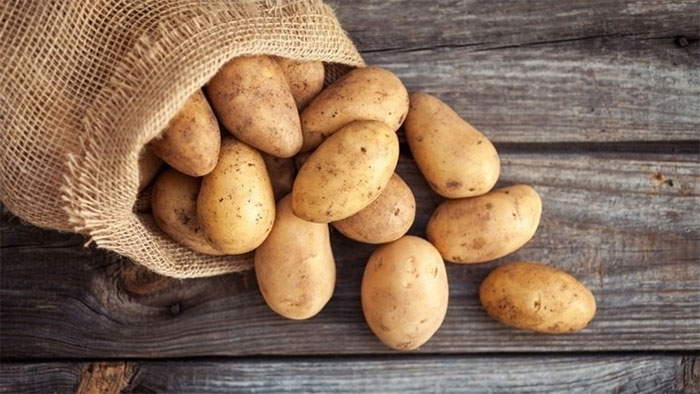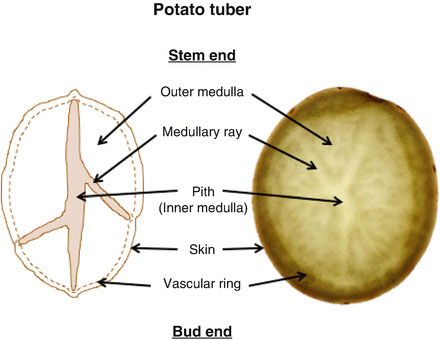Why do potatoes have eyes?
We must be no stranger to the small dents on the surface of a potato, often called the "eye". However, have you ever wondered why potatoes have eyes, or why they are called eyes and not other names?
Potatoes originated in the Andes (the border between Peru and Bolivia) and began to spread to Europe in the 16th century. Information from the International Potato Organization (the International Potato Center) said potatoes are one of the world's main food crops, the importance ranked third, behind only rice and wheat. And the eye, a part of a potato, turns out to be closely related to the vigorous growth and longevity of the crop.

Potatoes are one of the world's major food crops.
Nature is very magical. Most of the strange features that exist in plants and animals have their own reasons, often related to the purpose of breeding. The same is true for potatoes, the "eye" spots on the surface of the tubers play a role in the development of the next generation of potatoes.
Potato eye
The eye function is actually very simple: helping the potatoes grow . They are actually the mounds of the potato , but due to their resemblance to the eyes on a person's face, they are nicknamed "eyes". According to The Biology of Horticulture by John E. Preec e and Paul E. Read, the "eyes" are the undeveloped shoots themselves, and the "eyebrows" are scars from the Small leaves have grown on potatoes.

Anatomy of a potato
According to the Food and Agriculture Organization of the United Nations , a potato is divided into four sections: potato bowel (medullar ray, medulla or pith) that runs at the central, parenchyma tissue forms the bulk of a potato, ring of vascular bundles surrounding the tissue and dermal groups (skin or periderm)including the outer shell. Potatoes also have two distinct ends: the head and the bud. The tip of the stem is at the end of the potato, attached to the rest of the plant as the tuber grows into a large tree. The tip of the bud is where young shoots are formed, which is where we often see the potato eyes. A normal potato has 2 to 10 buds or twisted eyes scattered around the surface.
Usually the potato's eyes are small like dimples on the surface of the bulb, but when they germinate it is a sign that the potato is ready to be planted.
How do potatoes grow?
After being harvested, potatoes tend to "hibernate", meaning they don't grow up; instead, they store energy for the future. When the conditions are right, usually around 50 - 70 degrees Fahrenheit (10 - 21 degrees Celsius) combined with moisture in the air, they will stop hibernating and begin to grow. At this point, the potato will gradually convert starch into sugar, to provide fuel and energy for sprouting.
If a sprouting potato is planted in the right season with favorable weather conditions, the new potato can yield higher yields than before. The potato plant grows on the " mother tuber" and grows the entire trunk here. On the ground, we can see stems, leaves, flowers and fruits; meanwhile, under the ground, the "mother" will be the center that connects all the things on the ground with the ground, including the roots and a lot of underground stalks (called stolones) that grow from there. At the end of the stolon, tubers are formed.

Potato plant in practice.
The potato's mode of reproduction is called vegetative reproduction , but this is not the only way for potatoes to reproduce. Although potatoes produce seeds, plants grown from seeds "have unique characteristics," the potato breeding report is published on the University of North Dakota website.
Potato seedlings can have very different characteristics from the mother plant itself and with siblings that grow from the original parent seed. Therefore, seeded potatoes are rarely used for agriculture. This explains why plants for the purpose of providing agricultural products and food are often grown by vegetative reproduction. However, the report notes that potato seeding is also useful for crop improvement research programs.
Is it safe to eat sprout potatoes?
Frequently asked questions about potatoes and their eyes are often related to eating sprouted potatoes. This is easy to understand because the potato has sprouted buds with a quite strange shape.
The famous health website Healthline noted that potatoes and some other foods like eggplants, tomatoes, etc. contain two types of glycoalkaloid compounds, solanine and chaconine . In small quantities, these compounds appear to be quite safe, even beneficial. They are known for their antibiotic properties and ability to lower blood sugar, along with blood cholesterol. However, if taken in large amounts, they can become toxic.
When potatoes germinate, their glycoalkaloid content increases. Therefore, if you eat potatoes that are in the process of sprouting, the glycoalkaloid consumption may be higher than recommended. According to the National Capital Poison Center, case of consuming too much glycoalkaloid may experience symptoms of poisoning such as vomiting, abdominal pain, diarrhea, headache, panic and fever. These symptoms can appear anywhere on the body just a few hours after eating.

Potatoes have sprouted.
However, most experts agree that unless the sprouting potato is shrunken, wrinkled, soft, or discolored, it is safe to use, as long as the potato germ and eye are removed before processing. . (The pointed tip of a vegetable peeler can be used.) In 2019, Nora Olsen, a potato expert at the University of Idaho, told Eat or Toss that small pen tip-sized sprays are not a big deal, even if she herself Regularly use sprouted potatoes. However, always pay attention to cleanly remove the young shoots and cut off all potato eyes when cooking. Associate professor, Dr. Benjamin Chapman, food safety expert at the University of North Carolina, in 2017, when talking with the University of Iowa also expressed the same view: as long as the potato is still hard, firm , and during processing cut off the sprouts and the potato eyes.
In general, the best rule is not to eat when you feel the potato has a bitter taste, or when looking, smelling the potato with an abnormal smell. If there is any doubt about the status of the potato, be vigilant.
How to grow potatoes
Potatoes themselves are easy to grow, although the idea of using potatoes bought from the market to grow seedlings is not encouraged.
Potatoes at stores and supermarkets are often more or less processed to limit them from sprouting. Therefore, growing potatoes from food stores is not a good choice. Instead, Dr. Steven B. Johnson, an agricultural expert at the University of Maine Extension, recommends using certified potato seeds from reputable suppliers. Seeds are not seeds made from potatoes, but real pieces of potato, with one or more eyes. If the seed potato is smaller than 2 inches (5.08 cm) in diameter, it can be fully planted; If bigger, split it into several pieces, making sure each piece has at least one potato eye.
According to Garden Gate Magazine, potato seeds are best grown in early spring, or whenever the temperature falls around 50 degrees Fahrenheit (21 degrees Celsius). They will need a lot of sunlight and the soil has good drainage to grow. Make sure they are always well supplied. According to The Spruce 's guide , potatoes are ready for harvest after about 2 to 4 months, when the stalks on the ground start to fade and die.
- The truth about 3 taboo foods to eat with potatoes, this is the one thing that shouldn't be eaten the most
- Simple way of removing toxins in potatoes
- Potato vines do not produce tubers ... grow into fruits
- The best time to eat sweet potatoes
- Is eating green potatoes dangerous?
- Why should sweet potatoes be eaten?
- Practical benefits of potatoes
- Sweet potatoes and potatoes: Which is better?
- Bad health for eating potatoes the wrong way
- Discover the mystery of blight disease in potatoes
- The great cavalry when eating sweet potatoes, know that avoid if you do not want to 'carry serious disease'
- 19 most obsessive eyes in the history of world photography
 'Tragedy' the world's largest carnivorous life: Death becomes ... public toilet
'Tragedy' the world's largest carnivorous life: Death becomes ... public toilet Tomatoes were once considered 'poisonous' for 200 years
Tomatoes were once considered 'poisonous' for 200 years Detecting microscopic parasites on human face
Detecting microscopic parasites on human face Ghost orchid - expensive flower but the tree does not have a leaf
Ghost orchid - expensive flower but the tree does not have a leaf